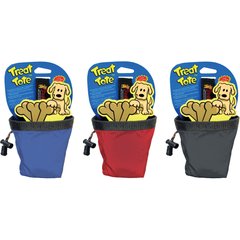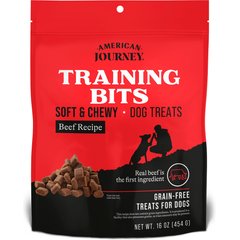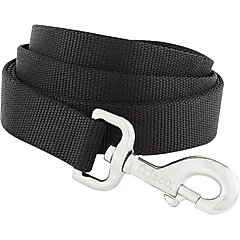How To Teach a Dog to Heel in 7 Easy Steps
Imagine if there were a dog command that could keep your dog close by your side, help you avoid dangerous interactions, and promote better leash manners and good behavior. Here’s the good news: The command exists, and it’s called “heel.” Teaching your dog to stay by you in heel position helps keep them safe, and also makes walks a lot easier on you both. So, how do you get started? We’re showing you how to teach a dog to heel in seven steps.
What Exactly Is the Heel Command, Anyway?
Heel training is different from regular leash training. With typical leash training, you’re training your dog to walk close enough to you to avoid pulling on the leash, aka loose leash walking. Heel position, on the other hand, is more precise. When you say the heel command, your dog should walk right beside you, so their neck or shoulder is more-or-less even with your leg.
Exact heel position can vary. For a small dog, their head and shoulder might be even with your ankles. For a very large dog, their neck might be by your chest. Traditional obedience competitions require dogs to heel on your left side, but you can choose to train both sides or the right side instead.
Why Should I Teach My Dog to Heel?
I like letting my dogs walk on a loose leash most of the time, but there are advantages to being able to say the heel command and have them quickly get into heel position:
- Heel position is a great place for a dog to be when a pet parent needs to keep distance between their dog and something dangerous, such as an unfriendly dog or broken glass on the street.
- The heel command is also useful for speeding up or slowing down as you walk. It trains your dog to pay attention to your body and move themselves accordingly, so they’ll be better able to keep pace with you.
- You can also use the heel command after exiting the house or the car, so your dog doesn’t move away while you lock the door. (If you’ve ever tried to insert a key in a lock with your dog pulling on your arm, you know this skill is priceless!)
How to Train Your Dog to Heel: Step by Step
1. Gather Supplies

You will need the following:
- A treat pouch (so your hands are free)
- Dog training treats
- A clicker (optional)
- A leash
- Masking tape
- Comfortable shoes
Recommended Products
2. Practice Handling the Leash and Dog Treats—Without Your Dog

You’re now ready to start the positive reinforcement training process. Before working with your dog, I recommend pretending to train a dog first. That might sound silly, but practicing without your dog lets you get comfortable handling the leash and dog treats (using treats while holding a leash can be challenging).
Follow these steps:
- Use masking tape to mark the spot on your leg where you want your dog to be. Place the tape at the height where your dog’s nose would be if they were standing next to you and looking forward, so they don’t have to reach or jump for the treat.
- Wearing the treat pouch with lots of treats inside, hold the leash in the hand on the opposite side from where your dog will be. So if you want your dog to heel at your left leg, hold the leash in your right hand. If you’re using a clicker, hold it in the same hand as the leash. Hold your other hand at about the level of your belly button.
- Say a word of praise (like “good”) or click your clicker, then take a treat from your treat pouch and pretend to feed it to your dog at the level marked by the masking tape. (You can just drop it on the floor.) Return your hand to the spot near your belly button. It sounds simple, but depending on the height of your dog, it can be tricky—and it’s essential that you can do this sequence smoothly to help your dog learn the command.
Once the sequence feels smooth and comfortable, move on to the next step.
3. Get Into Heel Position With Your Dog

Starting in a quiet, small room like a bathroom or small bedroom, put your dog on leash and stand so that they’re in the correct position for the heel command. You may need to adjust where you’re standing to make this happen.
Once your dog is in the right position, it’s time for you to do the same, with the leash in the opposite hand from where your dog is, and your treat-feeding hand at your belly button. If your dog knows the “stay” command, use it to keep them in one spot while you get yourself in position.
4. Practice the Heel Sequence With Your Dog

Once you’re both in the heel position, do the sequence you practiced in step 2: Click or praise your dog, grab a treat and feed it to your dog’s mouth at the spot by your leg you marked earlier. Do this three or four times so your dog gets used to being fed at the heel position. Remember to keep your treat-feeding hand at waist level, near your belly button, between feeding treats.
5. Take a Step Forward

Take a tiny step forward, keeping the leash loose. Don’t pull your dog; let them decide what to do. Wait for them to lean or step forward so they’re back in heel position. As soon as they are, praise or click, and feed a treat at the marked space by your leg.
If your dog does not step forward or seems stuck, walk around them in a circle, keeping your “heel” leg next to them until they stand up at roughly the right position. As soon as they do, praise/click and feed them a treat at the spot beside your leg.
Repeat this step until your dog moves forward with you every time you take a small step. Then gradually increase the size of your steps until you work your way up to your normal stride length.
6. Introduce the Heel Command

Next, start to say the word “heel” right before you take your first step. So you’ll say “heel,” take a step, then feed a treat at heel position when your dog steps forward with you. After feeding the treat, pause for a moment, then click or praise your dog.
Practice this until your dog reliably stays in heel position while you take normal-length strides. Then, experiment with skipping feeding the treat every two or three steps. Keep the treat pattern random, and remember to bring your hand back to your waist after every treat. If your dog stops heeling after a few steps with no treats, go back to feeding more frequently for a bit, and then reduce the treats more gradually.
7. Practice in Larger Spaces

Now that your dog is doing great in the bathroom or bedroom, start the process over in a larger room, starting at step 3 above. You will probably advance through the steps a little faster, but it’s important to practice from the beginning again to help your dog cement the learning. Work up to feeding only occasional treats in this new, larger space.
Once your dog is able to walk nicely in a larger room, practice in another part of your house. Be sure to start over at step 3 again.
Work your way up to practicing in your front or back yard, always starting over at step 3. If your dog continues to excel, start practicing on real walks. The outside world is exciting, so it’s important to start slow. With practice, your dog can heel by your side even on busy streets with people going by.
Bonus Step: Try It Off-leash
Up for an extra challenge? Start over at step 3 but with your dog off-leash! Most dogs can learn to heel well off-leash, but there are some precautions to take:
- Make sure you’re in an area that’s safe for your dog, even if they decide to run off—a fenced backyard or dog-friendly park, for instance.
- Leash your dog if anything could threaten their safety in the space where you’re training, such as an unfriendly dog.
- Obey all leash laws that apply to your area.
Training Tips and Tricks
- Practice in short training sessions lasting no more than five minutes.
- You may need extra-tasty treats to keep your dog’s attention outdoors at first.
- When you start using the heel command on walks, release your dog to sniff and explore as often as possible. Normal dog behavior involves stopping and even going backwards at times during a walk; dogs weren’t designed to walk forward at a steady speed. The heel command should be used only when you truly need your dog to stay close. If you keep your dog in heel position all the time, it makes dog walks less fun and less useful (since the walk will do less to meet your dog’s needs for mental stimulation). Let your dog set the pace!
- Having trouble with heel training? Consult a certified professional dog trainer.
Looking to do more dog training? Skills that pair well with leash walking include eye contact and hand targeting. You can also train your dog to sit whenever you stop walking while using the heel command.






